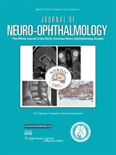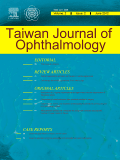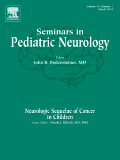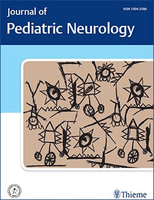
JOURNAL OF NEURO-OPHTHALMOLOGY
Scope & Guideline
Empowering Knowledge in Neuro-Ophthalmology
Introduction
Aims and Scopes
- Clinical Neuro-Ophthalmology:
Research primarily focuses on the clinical aspects of neuro-ophthalmology, including diagnosis and management of conditions like optic neuritis, idiopathic intracranial hypertension, and various forms of optic neuropathy. - Neuroimaging Techniques:
The journal emphasizes the use of advanced imaging techniques, such as MRI and optical coherence tomography, to enhance diagnostic accuracy and understand the pathophysiology of neuro-ophthalmic conditions. - Autoimmune and Inflammatory Disorders:
There is a significant focus on autoimmune and inflammatory diseases affecting the visual pathways, including giant cell arteritis and myelin oligodendrocyte glycoprotein antibody-associated disorders. - Genetic and Familial Disorders:
Research into genetic factors influencing optic neuropathies and other neuro-ophthalmic conditions is prominently featured, with studies exploring familial patterns and novel genetic variants. - Impact of Systemic Diseases on Vision:
The journal addresses how systemic diseases, such as diabetes and cancer, contribute to visual impairments and the mechanisms behind these associations. - Emerging Therapies and Interventions:
There is a notable emphasis on innovative therapies, including pharmacologic treatments and surgical interventions, aimed at improving visual outcomes in patients with neuro-ophthalmic disorders.
Trending and Emerging
- COVID-19-Related Neuro-Ophthalmic Complications:
A significant trend in recent publications is the exploration of neuro-ophthalmic complications arising from COVID-19 and its vaccines, reflecting the ongoing impact of the pandemic on ocular health. - Artificial Intelligence and Machine Learning:
Emerging studies on the application of AI and machine learning in diagnosing and managing neuro-ophthalmic conditions show a growing interest in utilizing technology to improve clinical outcomes. - Telemedicine in Neuro-Ophthalmology:
The journal is increasingly publishing articles on telemedicine, highlighting its role in expanding access to neuro-ophthalmic care, especially in the context of the COVID-19 pandemic. - Cross-Disciplinary Approaches:
There is a rising trend in interdisciplinary research that combines insights from neurology, ophthalmology, and other fields such as genetics and epidemiology to enhance understanding and treatment of neuro-ophthalmic conditions. - Patient-Reported Outcomes and Quality of Life:
An increasing emphasis on patient-reported outcomes and quality of life assessments indicates a shift towards understanding the holistic impact of neuro-ophthalmic disorders beyond clinical metrics.
Declining or Waning
- Basic Science Research:
The journal has seen a declining trend in the publication of purely basic science research, with a shift towards more clinically relevant studies and translational research. - Older Diagnostic Techniques:
There has been a noticeable decrease in articles focusing on traditional diagnostic techniques that have been largely replaced by more advanced imaging and diagnostic tools. - General Ophthalmology Topics:
Topics that are purely ophthalmological, without a neurological component, appear to be less frequently addressed, as the journal's focus narrows to the neuro-ophthalmic implications of visual disorders. - Historical Perspectives in Neuro-Ophthalmology:
Fewer articles are being published that focus on historical analyses or perspectives within the field, suggesting a trend towards contemporary issues and current research.
Similar Journals

Eye and Brain
Pioneering research at the intersection of ophthalmology and neuroscience.Eye and Brain is a distinguished open-access journal published by DOVE MEDICAL PRESS LTD, specializing in the interdisciplinary fields of ophthalmology and neuroscience. Since its inception in 2009, the journal has been committed to disseminating high-quality research that enhances understanding of visual perception and neural processes related to vision. With an impressive Scopus ranking in the 92nd percentile for Ophthalmology and the 89th percentile for Neuroscience Sensory Systems, Eye and Brain stands at the forefront of scientific inquiry, providing essential insights into cellular and molecular mechanisms underlying vision and sensory integration. The journal is dedicated to publishing articles that address critical challenges and advancements in these fields, making it a vital resource for researchers, professionals, and students alike. Situated in New Zealand, Eye and Brain not only represents a global collaboration in the eye and brain sciences but also offers a platform for groundbreaking research in the evolving landscape of sensory systems. Submissions are welcomed from across the globe, encouraging a broad spectrum of viewpoints and methodologies.

NEUROIMAGING CLINICS OF NORTH AMERICA
Unveiling the Future of Neuroimaging for HealthcareNEUROIMAGING CLINICS OF NORTH AMERICA is a premier peer-reviewed journal published by W B SAUNDERS CO-ELSEVIER INC, focusing on the evolving field of neuroimaging and its applications in clinical practice. Established in 1993, this journal has become a pivotal resource for researchers, professionals, and students alike, providing in-depth articles, reviews, and case studies that address both cutting-edge advancements and standard practices in neuroimaging. With its impressive credentials, ranking in the top quartiles of various medical categories—including Q2 in Medicine (Miscellaneous) and Q2 in Radiology, Nuclear Medicine, and Imaging—the journal is vital for advancing knowledge and clinical applications in the disciplines of neurology and radiology. Although it does not offer open access, the journal maintains a robust reputation with a broad readership, embodying a commitment to excellence in medical literature. The ISSN number is 1052-5149 and the E-ISSN number is 1557-9867, ensuring the accessibility and dissemination of high-quality neuroimaging research.

Journal of Diabetology
Unlocking insights in diabetes and metabolic disorders.The Journal of Diabetology, published by Wolters Kluwer Medknow Publications, is a premier platform dedicated to advancing the understanding and management of diabetes and related metabolic disorders. Since its inception in 2010, this Open Access journal has provided researchers and healthcare professionals with a wealth of knowledge through rigorous peer-reviewed articles that cover clinical research, epidemiology, and innovative treatment strategies. With an E-ISSN of 2078-7685 and a commitment to disseminating high-quality scientific work, the journal plays a pivotal role in contributing to the global discourse on diabetes care and prevention. Its dedication to accessibility enhances its impact on both established scholars and emerging researchers seeking to make meaningful contributions in the field. By fostering a collaborative environment, the Journal of Diabetology aims to bridge the gap between research and practical implementation, ultimately improving outcomes for individuals affected by diabetes.

Taiwan Journal of Ophthalmology
Empowering researchers to enhance vision care.Taiwan Journal of Ophthalmology is a premier open-access publication dedicated to advancing the field of ophthalmology. Published by Wolters Kluwer Medknow Publications, this journal has been a vital resource for researchers, practitioners, and students since its inception in 2012. With an ISSN of 2211-5056 and an E-ISSN of 2211-5072, it provides a platform for sharing innovative research, clinical findings, and reviews pertinent to eye health and vision science. The journal is indexed in Scopus and currently holds a Q3 quartile ranking within the ophthalmology category, reflecting its commitment to quality and relevance in the medical community. Located in Mumbai, India, Taiwans Journal of Ophthalmology aims to foster discussions and disseminate knowledge that promotes better understanding and treatment of ocular diseases, ensuring that the latest advancements reach a global audience. By embracing open-access policies, the journal underscores its dedication to making valuable insights readily available to all interested parties, thus contributing significantly to the discourse in ophthalmic research.

RETINA-THE JOURNAL OF RETINAL AND VITREOUS DISEASES
Advancing the Frontiers of Retinal HealthRETINA - THE JOURNAL OF RETINAL AND VITREOUS DISEASES is a premier peer-reviewed journal dedicated to advancing the knowledge and practice of retinal and vitreous disorders. Published by LIPPINCOTT WILLIAMS & WILKINS, this esteemed journal boasts a significant impact factor, affirming its standing in the academic community. With a long history of publication since 1981, its scope covers cutting-edge research and innovations aimed at improving patient outcomes in ophthalmology. As evidenced by its recent categorization in the Q1 quartile for both Medicine (miscellaneous) and Ophthalmology in 2023, the journal ranks impressively, placing it in the 84th percentile among its peers. Researchers, clinicians, and students will find valuable insights and evidence-based articles that contribute to the ever-evolving landscape of retinal health. RETINA remains committed to fostering an environment for scholarly dialogue and dissemination of knowledge, ensuring its readers are at the forefront of advancements in their field.

Annual Review of Vision Science
Transforming Research into Visionary ApplicationsThe Annual Review of Vision Science is an esteemed journal published by ANNUAL REVIEWS, focused on advancing the field of vision science through comprehensive reviews that synthesize current research and emerging trends. With an ISSN of 2374-4642 and E-ISSN 2374-4650, this journal has established itself as a leading source of high-quality academic content, boasting a prestigious Q1 ranking in the fields of Medicine (miscellaneous), Neurology (clinical), and Ophthalmology as of 2023. Its impressive Scopus rankings further attest to its influence, placing it in the top 5 within ophthalmology (96th percentile) and 31st in clinical neurology (92nd percentile). The journal aims to serve researchers, clinicians, and students alike by providing critical insights into vision science, thereby enhancing understanding and fostering innovation in both basic and applied research. Although not open access, the Annual Review of Vision Science remains a vital resource for those engaged in the study and application of vision science worldwide.

Seminars in Pediatric Neurology
Empowering practitioners with innovative insights.Seminars in Pediatric Neurology, published by W B SAUNDERS CO-ELSEVIER INC, is a prestigious journal dedicated to the evolving field of pediatric neurological disorders. Since its inception in 1994, this peer-reviewed journal has provided critical insights and cutting-edge research to support healthcare professionals in enhancing the quality of care for children with neurological conditions. With an impressive 2023 impact factor and a Q2 ranking in both the clinical neurology and pediatrics categories, it stands as a vital resource, fostering the dissemination of knowledge among researchers and clinicians alike. Featuring articles that explore a range of topics from clinical trials to innovative treatment modalities, this journal empowers practitioners with the latest findings in pediatric neurology. While primarily subscription-based, it plays a key role in bridging the gap between academia and clinical practice, making it an indispensable tool for anyone involved in the care and treatment of pediatric neurological patients.

EYE
Pioneering Research for a Brighter Visual FutureEYE is a prestigious peer-reviewed journal published by SpringerNature that serves as a cornerstone in the fields of Ophthalmology, Arts and Humanities, and Neuroscience. Since its inception in 1987, this influential journal has consistently maintained a Q1 Quartile ranking across multiple categories, showcasing its commitment to advancing knowledge and research in its disciplines. With a notable impact factor and a robust Scopus ranking—19th in Ophthalmology and 8th in Sensory Systems—EYE is vital for researchers, clinicians, and students alike, providing a platform for groundbreaking studies and critical reviews. While the journal operates under a subscription model, it ensures broad access to high-quality research, facilitating the dissemination of knowledge that shapes the future of eye health and sensory systems. With an address at Campus, 4 Crinan St, London N1 9XW, England, EYE continues to be a leading light in the understanding and advancement of visual health and sensory sciences.

Journal of Ophthalmology
Fostering Collaboration for a Brighter VisionThe Journal of Ophthalmology, published by HINDAWI LTD, is an esteemed open-access journal that has been disseminating significant research in the field of ophthalmology since 2009. With an ISSN of 2090-004X and an E-ISSN of 2090-0058, this journal facilitates global access to cutting-edge studies, making it an essential resource for researchers, clinicians, and students alike. Ranked in the Q2 category of ophthalmology for 2023, the journal holds a commendable position with a Scopus rank of #37 out of 137 in its field, placing it in the 73rd percentile. The journal encompasses a variety of topics such as clinical advancements, surgical techniques, and innovative technologies in eye care, aiming to advance scientific knowledge and clinical practice in ophthalmology. By providing a platform for both novel research and comprehensive reviews, the Journal of Ophthalmology is instrumental in fostering collaboration and scholarly communication within the global eye health community, and its commitment to open access ensures that impactful research reaches a wide audience without barriers.

Journal of Pediatric Neurology
Advancing the frontiers of pediatric neurology.Journal of Pediatric Neurology, published by GEORG THIEME VERLAG KG, stands as a dedicated resource in the field of pediatric neurology, navigating the complex interplay of neurological and developmental disorders affecting children. With its ISSN 1304-2580 and E-ISSN 1875-9041, this journal has been a pivotal platform for advancing research since its inception in 2003, and continues to present critical findings and discussions up to 2024. Although currently categorized in the Q4 quartile for both Neurology (Clinical) and Pediatrics, Perinatology and Child Health within Scopus rankings, the journal's commitment to fostering scholarly dialogue is essential for researchers, clinicians, and students dealing with pediatric patients. Its structured coverage of various neurological disorders, treatment strategies, and innovative therapies contributes to the broader understanding of pediatric neurology, despite the challenges noted in its ranking percentile. By encouraging submissions from diverse disciplines, the journal aims to enhance clinical practice and bridge gaps in knowledge, ensuring a multidisciplinary approach to child health and development.